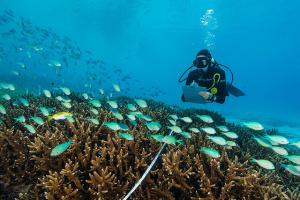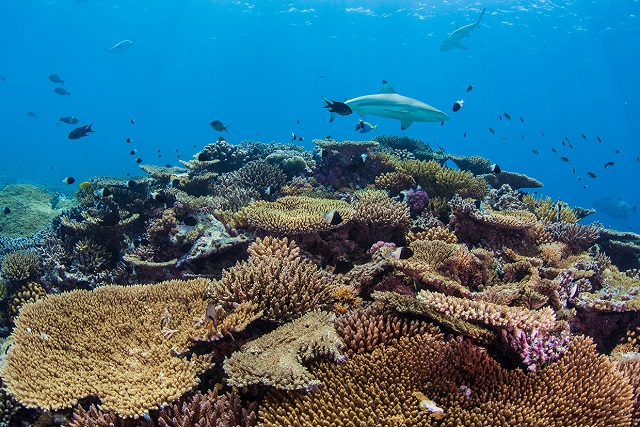Soft coral around 2 Seychelles islands suffered less than feared in 2015-17 warming, study finds
General |Author: Betymie Bonnelame | January 20, 2020, Monday @ 10:56| 6256 views
Emily Gadoutsis assessing the condition of the coral reef. (Ryan Daly/Save Our Seas Foundation)
(Seychelles News Agency) - Robust fish populations and a thriving marine ecosystem around two of Seychelles' islands could help the bleached coral reefs there, a new study found.
The changes in the type and condition of coral cover on the shallow reefs around D'Arros Island and St Joseph Atoll were documented in a study starting after the global bleaching episode in 2015 and just after raised sea temperatures subsided in 2017.
The Save Our Seas Foundation said in a communique on Monday that the conclusions were reported in a publication titled 'Post-bleaching mortality of a remote coral reef community in Seychelles, western Indian Ocean.' The publication which was written by Emily Gadoutsis, a student at the University of York, with support of the Foundation was published in the Western Indian Ocean Journal of Marine Science.
The study has helped to show that keeping fish populations stable and well-managed and limiting human disturbance around D'Arros Island and St Joseph Atoll will go a long way towards helping these coral reefs to recover.
Gadoutsis showed that nearly 50 percent of the hard corals around D'Arros Island and St Joseph Atoll were bleached in 2016, when sea temperatures rose around the world. Many coral reefs, including more than 70 per cent of the Great Barrier Reef in Australia, were devastated in this global event.
While the loss of hard corals around the two islands was extremely distressing, Gadoutsis found something surprising about this remarkable region of the Seychelles, an archipelago in the western Indian Ocean.
"Soft corals survived, and while many hard corals were lost, the nature of the sea floor's cover didn't completely change. In fact, some of the sites surveyed showed little mortality of corals of any kind. And deeper reefs, experiencing slightly cooler temperatures and covered in the kind of corals that are more resilient to temperature fluctuations, lost less hard coral cover to bleaching," reported Gadoutsis.
 |
| Sharks are an indicator of healthy coral reefs. A blacktip reef shark patrols a reef around D'Arros Island. (Ryan Daly/Save Our Seas Foundation) Photo License: All Rights Reserved |
Clare Daly, a co-author of the paper, said that once data from the whole survey region were analysed "we could see that there was actually potential for recovery in this area and that the results were different from what had happened elsewhere. That was motivating; the kind of impetus one needs to carry on with research. It's hopeful."
Coral bleaching is a phenomenon directly linked to the changing climate, the result of rising levels of carbon dioxide in the atmosphere. Reef-building corals in the tropics are colonial animals that are very sensitive to changing temperatures.
D'Arros Island and St Joseph Atoll, situated in the most remote reaches of the Amirantes region, have been relatively protected from overfishing, pollution, poor water quality and coastal development. These are all stressors that would otherwise reduce the resilience of the coral reefs.
The newly appointed chief executive of the Save Our Seas Foundation, James Lea, said, "In our increasingly warming world, the future of coral reefs might well rely on there still being a few remote and near-pristine wild places left in our oceans: precious places like D'Arros and St Joseph, where the marine ecosystem is resilient to critical events and corals may still have some form of safe haven."
Founded in Geneva, Switzerland in 2003, the Save Our Seas Foundation is a philanthropic organisation aimed at protecting and caring for the world's oceans.
Back
